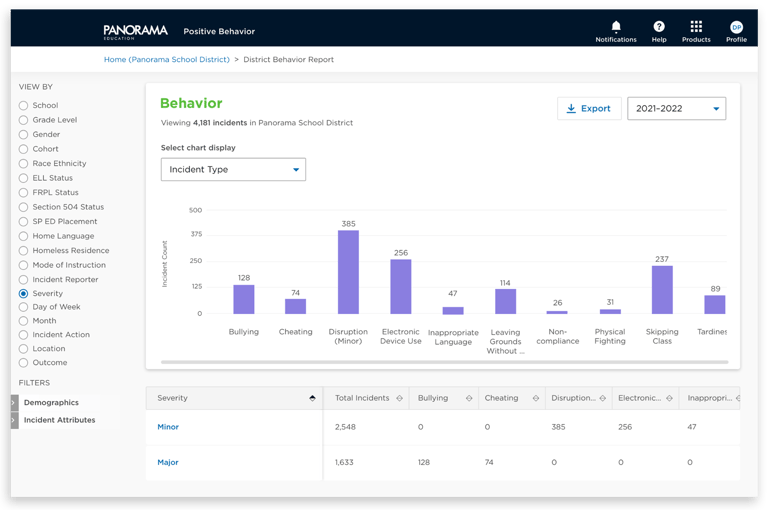Discover how Pittsfield Public Schools—a district of 5,000 students and 14 schools in Pittsfield, MA—uses accessible, actionable behavior data to create safe and predictable learning environments for all students.
Challenges
- District administrators spent significant time and resources creating behavior incident spreadsheets and charts—leaving little time for analysis and action.
- Schools lacked a shared method for tracking minor behavior incidents.
- District lacked a streamlined method of sharing behavior data with school leaders.
Solution
Results
- District now records all behavior data in one platform and can now take action on data to provide programming and develop interventions.
- Schools and districts can easily share student behavior data with families.
- Teachers and staff have a standardized method of tracking minor incidents.
- One elementary school saw a 75% decrease in behavior incidents after taking action to address behavior trends discovered in Panorama Behavior Logging & Analytics.
Challenges
“We had great ideas for how to use behavior data—but we had the roadblock of a giant spreadsheet. That was our biggest challenge,” says Bethany Nichols, Director of Social-Emotional Learning and Student Support at Pittsfield Public Schools.
It’s a challenge shared by schools and districts across the country. And like many districts, Pittsfield Public Schools in Pittsfield, MA, was facing a range of data collection and reporting barriers. They had to report major offenses to the state—but they lacked a streamlined reporting system, which made internal review challenging.
The district was using a reporting system to track both major and minor incidents. However, viewing that information in a comprehensive, actionable way required creating and manipulating a spreadsheet containing each school’s behavior information. Then, a school administrator would have to turn that spreadsheet into usable data.
While Pittsfield had a strong PBIS culture and many ideas of how they wanted to use data, they constantly faced these reporting and analysis roadblocks. School PBIS teams were spending precious time and resources building spreadsheets and creating bar charts—leaving no room for data-based planning and decision-making. District administrators needed access to useful, easy-to-read data that provided actionable insights on where to infuse supports.
Solution
Pittsfield started partnering with Panorama 2017, so district leaders were eager to implement Panorama Behavior Logging & Analytics when it was launched in 2022. The platform’s Behavior Logging and Behavior Analytics features allow for streamlined incident reporting and powerful behavior dashboards—meeting Pittsfield’s need for actionable, accessible data.
“That accessibility is extremely helpful,” says Nichols. “Now, more members of our team can access the data and have meaningful conversations about it. The willingness to use data has skyrocketed because the barrier of the extra steps—like creating charts or shuffling spreadsheet columns—has been removed.”
With Behavior Logging, teachers:
- Quickly and easily log both major and minor behavior incidents
- Track all important details such as incident type, students involved, location, date, and time
With Behavior Analytics, administrators and district leaders:
- Get real-time behavior data dashboards
- Configure reporting at the district level for consistent data collection across schools
- Zoom out to see district trends or drill down to school, teacher, and student level
The powerful, flexible dashboards provide the data Pittsfield needs to drive decisions around allocating resources and encouraging positive behavior supports. And the platform also gives the district the ability to ensure alignment with their Code of Conduct.
“The flexibility of the platform has been interesting for our district,” says Nichols. “We have five behavior levels in our Code of Conduct. Right now, Panorama gives us the ability to code major and minor incidents—but what’s coming is the flexibility to code behaviors at levels one through five. That way, we ensure we’re working with our district’s ‘restorative and accountable’ framework. We can feel confident that we’re setting up safe, predictable learning environments, and we can use data to better identify gaps in programming.”
Results
PBIS teams at Pittsfield use data from Panorama to identify opportunities for behavior interventions. Tracking minor incidents in Panorama Behavior Logging & Analytics helped one elementary school identify a specific location and time where many incidents occurred: the transition from recess to the lunchroom. They used that data to develop a special ticket for their PBIS program, creating an environment where students were more motivated to follow expectations during that transition period.
Another elementary school noticed an uptick in behavior incidents prior to school breaks. In December 2022, the school logged 24 incidents prior to their winter vacation. So school leaders implemented “double points” incentives in the week leading up to a school break—with an extra school store visit on Friday to motivate students to earn extra positive behavior points. It worked: in February 2023, in advance of their winter break, the school logged only 6 minor incidents.

Behavior incident data in Panorama Behavior Logging & Analytics. Please note that demo data is pictured.
Nichols notes that, in addition to providing schools with this type of actionable data, the platform also provides teachers and administrators a more comprehensive understanding of each student’s progress to share with families. “The support notes are fantastic, especially at the district level,” she says. “For example, if a parent calls to check in on their child’s progress, I can open Panorama and immediately see that student’s complete story. What’s been tried? What different behaviors and outcomes have they exhibited? Administrators really appreciate the ability to access and communicate that information quickly.”
Looking to the future, Nichols anticipates using data to make proactive decisions on providing these meaningful student supports. “I’m excited for school teams to get more comfortable pulling data and have standardized things to look for, to continue to base interventions on data,” she says. “Right now, we’re focused on the biggest fires or squeakiest wheel—but when examining data, we notice new things. We notice a quieter classroom, or we notice something happening on a bus. We’re making our decision-making process more data-based—less based on what someone feels. That will help us be more proactive than reactive. When we’re proactive, if we start to notice a pattern, we can intervene before the crisis point.”







